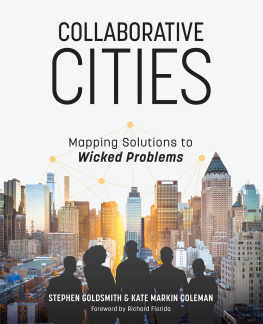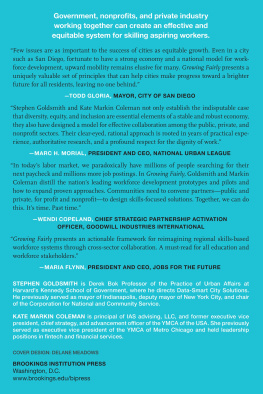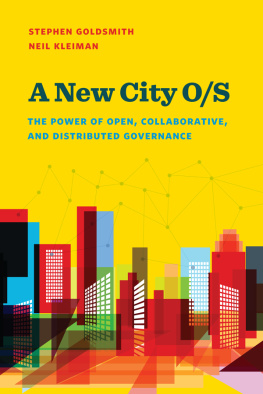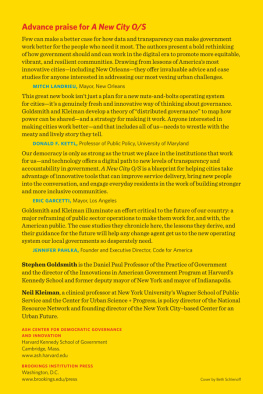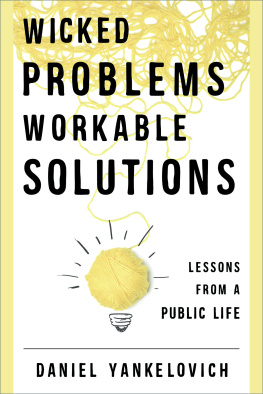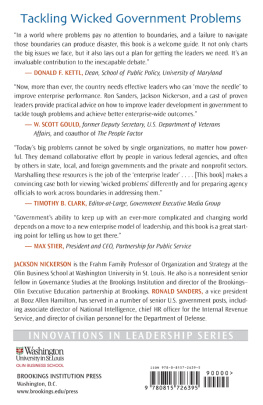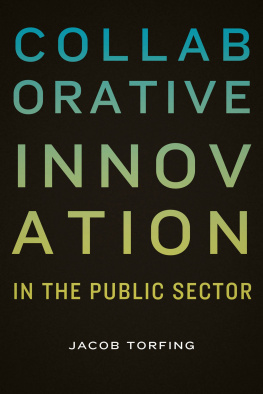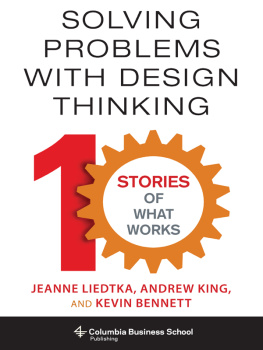Transcription:
Dynamic problems require dynamic collaboration and technology.
Our communities today face difficult issuessuch as climate change, access to health care, and homelessnesswhich are tangled, complicated, and constantly evolving. Coined wicked problems more than 40 years ago by the University of Californias Professors Horst Rittel and C. West Churchman, these issues exceed the capacity of any one sector, instead demanding the kind of creative thinking, democratized engagement, and integrated action that come from government, nonprofits, businesses, and citizens working in concert.
Starting with Collaborative Cities, government officials, nonprofit leaders, and citizens alike who are acting for social value can learn how to use a geospatial approachthe commonality in driving social outcomesto improve insight and trust and the efficacy of their combined efforts to solve wicked problems.
Stephen Goldsmith was the 46th mayor of Indianapolis and also served as the Deputy Mayor of New York City for Operations. He is currently Derek Bok Professor of the Practice of Urban Policy and director of Data-Smart City Solutions at the John F. Kennedy School of Government at Harvard University.
Kate Markin Coleman has 30 years of experience as a senior executive in the private and social sectors including executive vice president, chief strategy and advancement officer at YMCA of the USA. She now serves as adviser to, and on, the boards of social enterprises.
Esri Press, 380 New York Street, Redlands, California 92373-8100Copyright 2021 Esri
All rights reserved.ISBN: 9781589485396e-ISBN: 9781589485402
The Library of Congress has cataloged the print edition as follows: 2021943859The information contained in this document is the exclusive property of Esri unless otherwise noted. This work is protected under United States copyright law and the copyright laws of the given countries of origin and applicable international laws, treaties, and/or conventions. No part of this work may be reproduced or transmitted in any form or by any means, electronic or mechanical, including photocopying or recording, or by any information storage or retrieval system, except as expressly permitted in writing by Esri. All requests should be sent to Attention: Contracts and Legal Services Manager, Esri, 380 New York Street, Redlands, California 92373-8100, USA.The information contained in this document is subject to change without notice.US Government Restricted/Limited Rights: Any software, documentation, and/or data delivered hereunder is subject to the terms of the License Agreement. The commercial license rights in the License Agreement strictly govern Licensees use, reproduction, or disclosure of the software, data, and documentation. In no event shall the US Government acquire greater than RESTRICTED/LIMITED RIGHTS. At a minimum, use, duplication, or disclosure by the US Government is subject to restrictions as set forth in FAR 52.227-14 Alternates I, II, and III (DEC 2007); FAR 52.227-19(b) (DEC 2007) and/or FAR 12.211/12.212 (Commercial Technical Data/Computer Software); and DFARS 252.227-7015 (DEC 2011) (Technical Data Commercial Items) and/or DFARS 227.7202 (Commercial Computer Software and Commercial Computer Software Documentation), as applicable. Contractor/Manufacturer is Esri, 380 New York Street, Redlands, CA 92373-8100, USA.@esri.com, 3D Analyst, ACORN, Address Coder, ADF, AML, ArcAtlas, ArcCAD, ArcCatalog, ArcCOGO, ArcData, ArcDoc, ArcEdit, ArcEditor, ArcEurope, ArcExplorer, ArcExpress, ArcGIS, ArcGIS CityEngine, arcgis.com, ArcGlobe, ArcGrid, ArcIMS, ARC/INFO, ArcInfo, ArcInfo Librarian, ArcLessons, ArcLocation, ArcLogistics, ArcMap, ArcNetwork, ArcNews, ArcObjects, ArcOpen, ArcPad, ArcPlot, ArcPress, ArcPy, ArcReader, ArcScan, ArcScene, ArcSchool, ArcScripts, ArcSDE, ArcSdl, ArcSketch, ArcStorm, ArcSurvey, ArcTIN, ArcToolbox, ArcTools, ArcUSA, ArcUser, ArcView, ArcVoyager, ArcWatch, ArcWeb, ArcWorld, ArcXML, Atlas GIS, AtlasWare, Avenue, BAO, Business Analyst, Business Analyst Online, BusinessMAP, CommunityInfo, Database Integrator, DBI Kit, EDN, Esri, esri.com, EsriTeam GIS, Esri
The GIS Company, EsriThe GIS People, EsriThe GIS Software Leader, FormEdit, GeoCollector, Geographic Design System, Geography Matters, Geography Network, geographynetwork.com, Geoloqi, Geotrigger, GIS by Esri, gis.com, GISData Server, GIS Day, gisday.com, GIS for Everyone, JTX, MapIt, Maplex, MapObjects, MapStudio, ModelBuilder, MOLE, MPSAtlas, PLTS, Rent-a-Tech, SDE, See What Others Cant, SML, SourcebookAmerica, SpatiaLABS, Spatial Database Engine, StreetMap, Tapestry, the ARC/INFO logo, the ArcGIS Explorer logo, the ArcGIS logo, the ArcPad logo, the Esri globe logo, the Esri Press logo, The Geographic Advantage, The Geographic Approach, the GIS Day logo, the MapIt logo, The Worlds Leading Desktop GIS, Water Writes, and Your Personal Geographic Information System are trademarks, service marks, or registered marks of Esri in the United States, the European Community, or certain other jurisdictions. Other companies and products or services mentioned herein may be trademarks, service marks, or registered marks of their respective mark owners.For purchasing and distribution options (both domestic and international), please visit esripress.esri.com.163955
Acknowledgments
We thank the social sector and government leaders who shared their experience with us and who have been tireless in their efforts to improve the lives of the people who live in the communities they serve. We are inspired by their commitment and humbled by their perseverance.
To Kate Bauer and Kate Murphy, we thank you for your ideas, organization, and keen eyes.
To Matt Leger, we owe you a debt of gratitude. Without your insights, diligence, research, and writing, this book would not exist. Thank you.
Foreword
When I was asked to review a book that combines maps and a practical understanding of local issues with a clear eye toward new and more collaborative models, I was curious. Well, after reading Collaborative Cities, consider me hooked.
Collaborative Cities comes at a critical juncture in Americas history. At a time of deepening political divide and increasing national dysfunction, we cannot count on our federal government to solve all our problems. Yet, while just a third of Americans have any faith and confidence in the federal government, more than three-quarters of Americans still have great confidence in their local governments. Now, more than ever, it will be up to our communities and neighborhood leaders to address the many vexing, or wicked, problems of our time. This book delivers a primer on place-based policy responses to these problems.
It has become clich to say that cities are the future. But not all cities are the same. More people live in suburban and rural communities than in large urban centers. All these places, all these communities, all these neighborhoods, have distinctive assets, features, and characteras well as unique problems and challenges.
Legendary urban planner Jane Jacobs liked to say that a city is, after all, a federation of neighborhoods. As such, our country needs a local perspective to address inequality and rebuild communities. We face not just economic inequality but worsening spatial inequality. As the middle class and its once-robust neighborhoods have declined, our communities have fractured into areas of concentrated advantage and even larger areas of concentrated (often racially concentrated) disadvantage. Addressing this disparity requires place-based policies that can activate and strengthen local assets and the connective fiber between residents of disadvantaged neighborhoods and areas of economic growth and opportunity. The books overarching perspective, its focus on cross-sector collaboration, and its use of maps and spatial analytics are all tools to empower and embolden neighborhoods and their residents to effect change.

